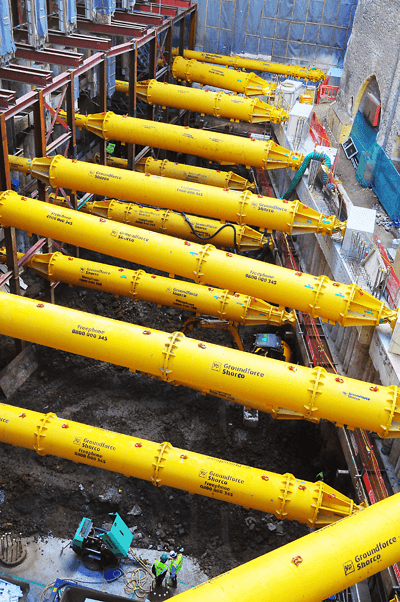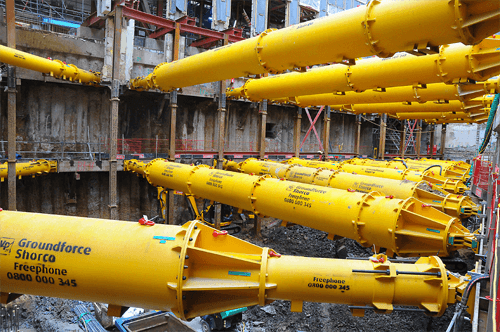Groundforce Shorco’s Major Project Team designed a complex basement propping solution for one the UK’s
most delicate and challenging redevelopment projects in London - 5-7 St Helen’s Place, the residence for The Worshipful Company of Leathersellers, one of the City of London’s Livery Companies.
The Project
 Located within the conservation area of St Helen’s Place, the building includes a new two story basement Livery Hall and six storey superstructure above the new basement Hall, which will be used for office accommodation. The top level of the development will contain a 3-bedroom Master’s Flat with a biodiverse green roof.
Located within the conservation area of St Helen’s Place, the building includes a new two story basement Livery Hall and six storey superstructure above the new basement Hall, which will be used for office accommodation. The top level of the development will contain a 3-bedroom Master’s Flat with a biodiverse green roof.
Working for principle contractor Brookfield Multiplex, specialist contractor O’Keefe Construction (Greenwich) Limited had to completely demolish the existing building, retaining the elegant 1919 Portland stone façade, in order to construct the new building.
With part of the design requiring the enlargement of the existing basement, O’Keefe had to extend down another 6m to create the two-storey basement. Groundforce supplied 22 of its massive MP250 hydraulic props, which were installed by O’Keefe to support the sides of the two-storey excavation, which is situated in an incredibly tight site.
The Challenges
Poor ground conditions and the close proximity of neighbouring buildings were the biggest challenge to the construction team. The excavation occupied the entire site, which measured approximately 44m x 25m and is hemmed in on every side by existing structures.
Most delicate of all was the 800 year old Grade I-listed Church of St Helens Bishopsgate which adjoined most of the southern boundary of the site.
The temporary propping solution had to ensure that the potential for ground movement was absolutely minimal in order to avoid damage to the church and the retained façade which was supported on steelwork, designed and installed by O’Keefe, cantilevered over the edge of the excavation.
After the installation of a concrete secant piled wall, a reinforced concrete ring-beam was cast on top with special concrete bearing blocks incorporated into it. These blocks provide perpendicular restraints for the Groundforce MP250 props.
Perpendicular connections were required as this reduced the acting shear forces; thus minimising the number of anchors required to fix the props – making for a simpler and quicker installation.
The Solution
The traditional method of installing bespoke steelwork within the excavation – would have been very slow and labour-intensive; it would also have been difficult to assemble within the narrow confines of the site. A quicker solution was to install modular hydraulic props which could be lifted in by the site tower crane and quickly extended between end bearings and pre-loaded to provide stability.

The system chosen was Groundforce’s MP250 – one of the largest standard prop types available in the UK and each capable of supporting a load of up to 250 tonnes.
Most of these 22 props utilised Groundforce’s 1220mm diameter “supertube” extensions; only those providing additional corner bracing were fitted with the usual 610mm diameter tubes, to maximise the stiffness of the temporary supports. The actual design load was typically around 50% of the capacity of the props for the upper level and 70% of the capacity for the lower level.
The 1220mm supertube extensions are usually used where the props have to span wide excavations without intermediate supports. Although these tubes allow clear spans of up to 50m, nowhere here was the span more than 25m and most were substantially less than this.
The props were installed at two levels, the lower level bearing on a steel waling beam fixed around the perimeter of the secant piled wall. The total depth of the excavation was 9.2m.
To further ensure maximum rigidity in the system, each of the props was mechanically ‘locked-off’ with steel rods once the correct extension had been set hydraulically. A hydraulic system by its nature is not quite as stiff as a rigid steel prop, and whilst this can provide design benefits, in this case rigidity and minimal deflection was the priority, so the lock off method was adopted.
Throughout the excavation process, the loads acting on the props were recorded in real time using Groundforce’s own load monitoring system. Strain gauges in the prop’s end connection pin transmit signals to an onsite GPS/ SMS transmitter. This sends readings to a remote server which is accessed by a secure website by Groundforce, the client and other authorised parties.
The system not only records actual loads and temperature, but can also be configured to notify named recipients if readings approach or exceed pre-set trigger levels.
We opted to use the flying shores from Groundforce as it proved to be the most appropriate method of installing the props in sections to accommodate the complex excavation sequence.
Lee Horsley, Operations Director - O'Keefe
Download PDF